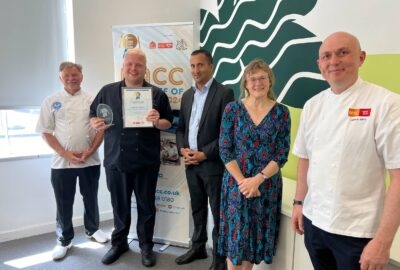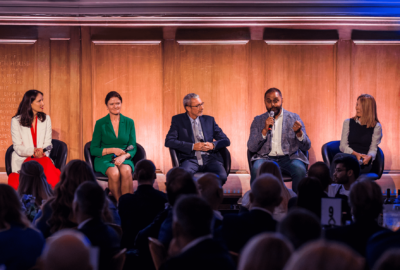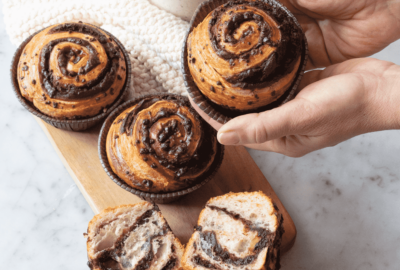After helping to shine a light on the quality of chefs working within the care sector last year as he stormed into the quarter finals of MasterChef The Professionals, talented Scottish chef Ross Burgess has now embarked on his next adventure within the school sector after joining Gordonstoun, where HRH Prince Charles and his father were both former pupils.
Was a career in the kitchen always the plan?
Not at all. It was something I fell into after leaving school at 16 and needing a job. My mum was a bit sick of me being around the house so I started working in a small local Italian restaurant as a commis chef. I learnt on the job, was given more responsibility and fell in love with it from there. Next I completed my SVQs and HNC at the University of the Highlands and Islands and then I worked in hotels and did a few stages in Edinburgh including one with Tom Kitchin, before heading off travelling.
Where did you go travelling and how did it shape you as a chef?
I went travelling when I was 22 and got back when I was 28 so it was huge part of my development as a person and a chef. I visited about 49 different countries across Europe, Asia and Australasia so the amount of ingredients, cuisines, cooking styles and tastes I was exposed to was unbelievable. I had a working visa in Australia and it was really when I was there that my eyes were opened to just how exciting the restaurant and wider food industry could be. When I first arrived, there were fruits, vegetables and a wide array of fish species that I had never heard of, never mind tried, so in some respects I was almost starting from scratch. It was a new level for me and working throughout Australia in Sydney, Perth and Darwin, plus in New Zealand, changed my outlook. It gave me the confidence and fuelled my passion to really push myself in food.
How did you end up working in the care sector?
On arriving back from my travels, I went straight back into work at a small restaurant called Forage and Chatter in Edinburgh. It was a fantastic place to work but the hours were hellish. I realised I was speaking to my family more when I was on the other side of the world. I ended up looking away from fine dining and applying for a job in the care sector. It was a new build so was only 3 months old, the kitchen was top of the range and everything on the menu was made from scratch in-house. It was a bit simpler than what I was used to but the freshness, quality ingredients and philosophy behind the food was no different.
What’s your biggest achievement?
I have been very lucky and I am proud of everything I have achieved and all the places I have visited but MasterChef will always take some beating. I think they get over 5,000 entrants so to make it just down to the final 32 was an achievement in itself.
Did the MasterChef experience make you a better chef?
Not necessarily a better chef but definitely a better person. As soon as the pressure hit me, I was just trying not to crumple in a heap on the floor but to cook well and get some amazing feedback for some of my food from the best has improved me hugely. I’m actually going up Ben Nevis in a few weeks to put myself out of my comfort zone again and that has come from the MasterChef experience. It’s about pushing yourself and realising you can do anything. I’m surprised at how long that feeling is lasting but so much has happened off the back of it.
How important is the food to the school and the pupils at Gordonstoun?
Like with the curriculum and extra-curricular activities, it’s about pushing boundaries for the pupils eating it and for our team preparing it. We’re feeding 600 kids three times a day with a bakery section running around the clock for additional snacks. An old oak tree over the road had to be felled recently so we used the wood chips to smoke our own salmon. We created eggs benedict with our own school smoked salmon on home-baked English muffins – not your average school breakfast. We run a ‘Fish Friday’ and serve a classic ‘Sunday Roast’ that they love but in my time at the school I don’t think I have cooked the same dish twice. We had ‘International Week’ recently so we were doing Serbian Cevapcici, which gives you an idea of the freedom we have and the variety the pupils get.
What’s your favourite ingredient
Soy sauce – it’s just so versatile and can elevate anything. On its own, cooking with it, marinating with it, reducing it, dipping it or seasoning with it, it’s just intense. You don’t get a good cheap soy sauce. You get what you pay for so pay the extra for a good one.
What are your three outdoor cooking secrets?
1. Investing in good tools and then looking after them makes a big difference. It’s more enjoyable, you will do a better job and take more pride in it.
2. Good personal appearance. If you look good, you will feel good, you cook good. Don’t wake up 5 mins before you leave the door.
3. It’s obviously been a bit difficult recently but I think shaking hands with your team when you arrive and then when you leave is very important. It’s about attacking the day as a team and then drawing a line under it at the end together, whatever has happened. If something has gone badly, it ends each day and you start afresh tomorrow.
Can you tell us a recipe that is special to you and why you have chosen it?
I’m choosing this Sirloin of Aberdeen Angus recipe as it showcases some fantastic Scottish ingredients elegantly lifted with some key
Asian flavours.
Sirloin of Aberdeen Angus
Ingredients
For the Beef
1 Sirloin of Aberdeen Angus Steak (300g)
15ml Vegetable Oil
100g Butter
4 Cloves Garlic
For the Mushroom Puree
250g Flat Cap Mushrooms
1 Brown Onion
4 Cloves Garlic
100ml Chicken Stock
100ml Double Cream
50g Butter
For the Ponzu Mushrooms
300g Oyster Mushrooms
200g Potato Starch
15ml Vegetable Oil
150ml Kikkoman Soy Sauce
2 Lemons
1 Orange
50ml Rice Wine Vinegar
For the Pickled Radish
8 Red Radishes
100ml Mirin
100ml Rice Wine Vinegar
For the Beef Sauce
3 Brown Onions
1 Bulb Garlic
3 Carrots
1 Head of Celery
1 Leek
50g Tomato Puree
1.5 Litre Chicken Stock
100g Oyster Sauce
75ml Kikkoman Soy Sauce
For the Sliced Raw Mushroom
100g Chestnut Mushrooms
For the Coriander
1 Punnet Micro Coriander
For the Lotus Root
300g Lotus Root
METHOD
For the Beef Sauce
1. Place the vegetables along with any cuts of beef in a large saucepan and sauté over a medium high heat until dark and caramelised.
2. Add the soy to deglaze.
3. Add the beef stock and reduce over a medium heat, cook until reduced by half.
4. Strain through a chinois to remove large pieces not needed, and then though a muslin cloth to remove any smaller pieces.
5. Reduce to an almost thin syrup consistency, check seasoning.
For the Mushroom Puree
1. Dice the flat cap mushrooms, the onion and garlic and add to a saucepan with a little oil and the butter.
2. Cook on a medium high heat, stirring every couple of minutes.
3. After several minutes add the stock and allow to reduce by half.
4. Add the cream and allow to reduce.
5. Once the liquor has reduced enough so it’s only really coating the mushrooms, blend in a blender on high spend until silky smooth, pass through chinois if needed.
6. Check seasoning, place into squeeze bottle and keep warm.
For the Ponzu Mushrooms
1. For the Ponzu Mushrooms, place the soy in a bowl gradually add the juice of the orange, lemons and vinegar until desired acidity levels are reached, set aside.
2. Slice the oyster mushrooms in half if needed. If not too big, leave whole, lightly coat in a little oil and dredge in the potato starch.
3. Fry in the deep fryer for around 1 ½ minutes until crispy.
4. Remove from fryer onto paper towel to drain, add to ponzu to soak.
5. Lightly warm in the oven, closer to plating.
For the Sliced Raw Mushroom
1. Thinly slice the mushrooms and keep aside for plating.
For the Pickled Radish
1. Leave around 2-3mm of green stem on the radish and discard the rest.
2. Cut into quarters.
3. Steep in the mirin and rice wine vinegar.
For the Lotus Root
1. Peel and slice the lotus root nice and thin on the mandolin.
2. Plunge straight into the fryer to avoid going brown and fry until golden and crispy. Remove from fryer, sprinkle with a little salt, and set aside for plating.
For the Beef
1. Remove beef from fridge at least 20 minutes before cooking to help come to room temperature for a more even cook.
2. Put frying pan on the stove to reach temperature.
3. Once it has reached temperature add a little oil.
4. Season the beef lightly with salt and pepper, and add to the frying pan.
5. After 2 minutes of frying, add the butter and garlic and baste the meat.
6. Once cooked to just before your liking remove from the pan and leave to rest, (the meat will continue cooking a little while resting). Once rested the meat should be perfect.
7. Cut into three pieces and plate.



